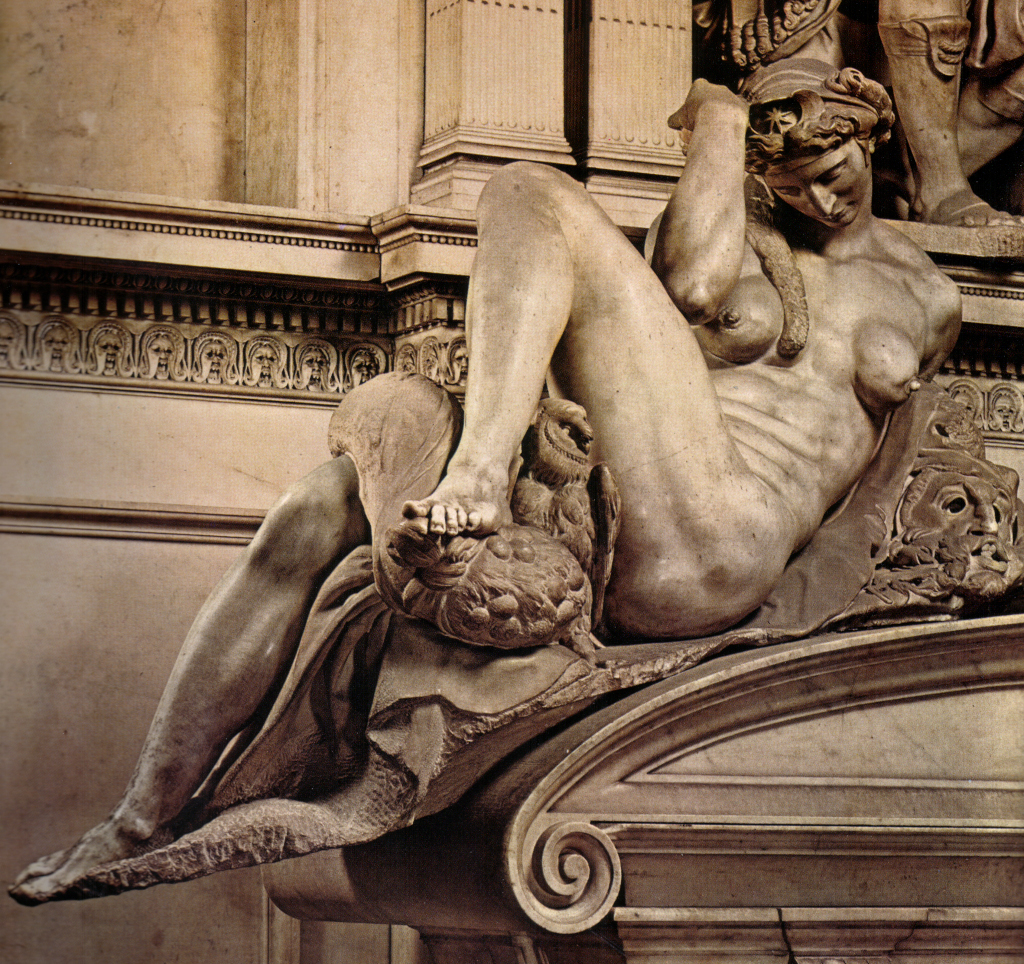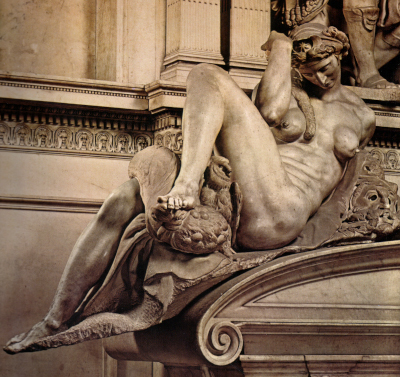Introduction
Michelangelo received an important commission in around 1520 which underlined the strength of his relationship with the Medici family. He would be entrusted with designing the Sagrestia Nuova (New Sacristy), in which four tombs for the Medicis would be constructed, along with a plethora of Renaissance sculpture and architecture. At that stage, Michelangelo was relatively experienced within the field of architecture, and so this commission brought him many new opportunities.
Ultimately, the artist would move on before the original designs were complete, but two tombs remain that were finished to a high degree, other than a few elements around each sculpture. The tombs of Giuliano Lorenzo de' Medici and Lorenzo de' Medici each received three sculptures, and followed a similar format to each other. Typically, there would be two figures in the lower half, stretching out and down, based on related themes, plus a portrait of the figure buried in the tomb, placed just above.
Within the tomb of Giuliano Lorenzo de' Medici, we find Night placed on the left hand side, if we are looking at it from the centre of the room. The piece is formed from marble, with a smooth finish in the parts that were entirely finished. The features are slightly more complete than in its companion, Day, particularly with regards the face. Michelangelo normally covered men within his sculptures, making Night an important addition to his oeuvre.
Table of Contents
- Introduction
- Description
- Inspiration, Meaning and Preparation
- Critical Reception and Poetry
- Copy of Night exists in the Pushkin Museum, Moscow
- Size and Medium
Description
Night rests her head just below the right leg of Giuliano de' Medici. She leans her head slightly away from us, lifting her bent right arm up alongside. Her eyes are closed, and she has pretty features, with a small, delicate face with a straight, prominent nose and small pursed lips. Her hair is curled, but short and sits beneath some sort of headwear which contains a star shape in the centre (this is likely to actually be a representation of the sun, with rays of sun shooting outwards). This hat or helmet appears possibly inspired by classical art or mythology, leading us to learn more about the identity of the figure herself.
The female figure is unclothed, but her left leg is angled in a way that protects her modesty. She is highly toned around the stomach, which is typical of Michelangelo's work, but not to the same level as he would implement with his male figures. She is left on rough stone, which from a distance appears unfinished, but actually is just a variation in surface. Owls have been carved into parts of this rougher looking stone.
Night's chest is not entirely precise in terms of representing the true female body, and looks more like an idealised, imagined version as in the mind of the artist. Michelangelo was more experienced in capturing the male body, and one might argue was also more accurate in understanding its quirks, as compared to the female body. The lack of female sculptures within this artist's career also led to Night receiving more attention than some of the other items that he completed within the two tombs.
Research into the origins of the female figure, specifically who inspired Michelangelo's Night sculpture, would reveal that she is likely sleeping within this depiction. Michelangelo called upon influences from classical art within this series of four sculptures, before adding his own impressive technical expertise in order to deliver Day, Night, Dawn and Dusk, alongside the two portrait sculptures of Lorenzo and Giuliano.
Inspiration, Meaning and Preparation
Preparation
Michelangelo spent a considerable amount of time in sketching out his plans for the sculptures and architecture that would adorn the new Medici Chapels. Four tombs were planned in total, with two eventually being completed, other than for a few final touches. Michelangelo was not experienced in architecture by the time he received this commission, and so would have spent some time researching ideas in order to meet the requirements of the Medici family. There was always a strong connection between his sculptures and his drawings, both of which displayed an incredible understanding of the human body. Michelangelo tended to focus more on the male figure, meaning for his two female sculptures, additional research and practice was required.
Meaning
A number of study drawings were discovered hidden in a room which lay beneath the main structure of San Lorenzo in Florence. These resemble the sculptures which became his Times of the Day series, but most accurately follow the style of Night. These include the crescent moon and the rays of the sun, the latter of which was also included the final sculpture found in this page. The moon would also be included too, upon her jewellery.
The mask by her left arm is believed to represent a negative type of dream, whilst the owl relates to the topic of sleep. By contrast, the other figures covered by Michelangelo for the two tombs are not filled with the same types of detail, making them harder to understand and identify.
Inspiration
Michelangelo is known to have studied and sketched a famous ancient sculpture known as The Sleeping Ariadne, which is located in the Vatican Museums in Vatican City. Elements of its design would inspire Night, as well as Dawn. Indeed, he would have worked on the four related sculptures at the same time, as the tombs started to take shape in the early 16th century.
The ancient sculpture dates to Roman times, and the Vatican version that Michelangelo would have studied was actually a copy from an earlier piece of several centuries earlier. The piece is also sometimes known as Cleopatra, and is described by some as being amongst the most famous ancient sculptures in European history. The specific elements of it that influenced the design of Night was the angle of the arms in relation to her head, and the overall reclining posture.
Critical Reception and Poetry
A good number of artists and poets have marveled at this particular piece, with a number of poems featuring it as their inspiration. Some of these responses came during Michelangelo's own lifetime, and he famously defended his work in a particularly aggressive manner, even when comments were not particularly critical. In most cases, thankfully, this rudeness was not required as the sculpture was broadly well received. Its status as a female figure perhaps explains why Night attracted so much attention, more so than other pieces in Michelangelo's Times of the Day series.
"Night, whom you see sleeping in such sweet attitudes
Giovanni Strozzi, as quoted by Giorgio Vasari
was carved in this stone by an Angel
and although she sleeps, she has life:
wake her, if you don't believe it, and she will speak to you..."
Copy of Night exists in the Pushkin Museum, Moscow
The inspirational work of Michelangelo has captured the imagination of artists all around the world for centuries. A good number of made sketches of his sculptures, whilst viewing his work in person, whilst a number of sculpture copies have also been made. A high quality copy of Night can be found in the Pushkin Museum, Moscow, for example. It is a part of the Tsvetaev Collection of Plaster Cast Reproductions and the whole tomb was recreated in this manner.
Size and Medium
The stretched figure of Night measures around 194 cm at its longest. It dates to around 1526–1531, though a precise year is hard to ascertain, because of how the artist worked on multiple sculptures and projects at the same time. Michelangelo would also regularly leave items unfinished for a period, before returning to them at a later date.
Image Credit
The image included within this page is a smaller and larger format of a picture taken from Umberto Baldini, Michelangelo scultore, Rizzoli, Milano 1973. It is classed as being in the public domain, and was uploaded to Wikimedia Commons by user Adri08. The contribution is much appreciated, and many more photographs of Michelangelo's sculptures can be found on that impressive resource.
Night, 1526-1531 by Michelangelo, originally from Umberto Baldini, Michelangelo scultore, Rizzoli, Milano 1973; Adri08 (uploaded), Public Domain, via Wikimedia Commons
 Night (Detail) by Michelangelo
Night (Detail) by Michelangelo
Bibliography
- Images sourced from Wikimedia under a variety of Creative Commons licenses. Further details regarding the particular license used, the location of the original image on Wikimedia and the original author/user are provided on each specific page.
- Michelangelo, Gilles Néret
- Vasari's Lives of the Artists, Giorgio Vasari
- Michelangelo. The Complete Works. Paintings, Sculptures, Architecture, Frank Zöllner, Christof Thoenes
- Michelangelo and the Sistine Chapel, Andrew Graham-Dixon





